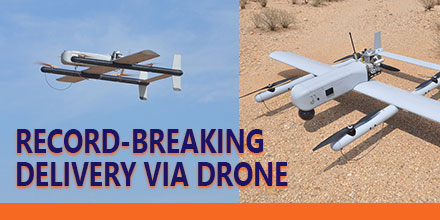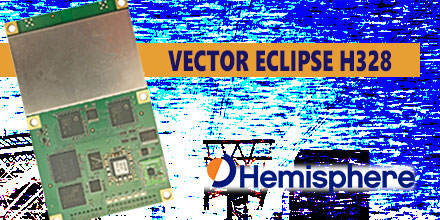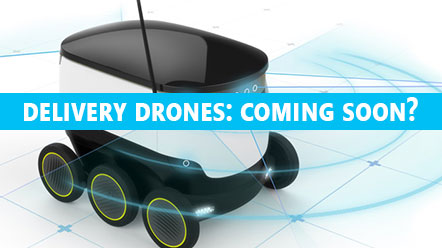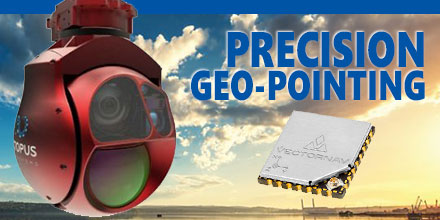
A record was recently set in long-distance delivery via drone. The record-breaking event took place
May 5, 2017 and involved several key stakeholders.
The Nevada UAS Consortium, dubbed Team Roadrunner, flew a fixed-wing Unmanned Aerial Vehicle (UAV) over 97 miles to
Austin, Texas through use of cellular connectivity.
Delivery via Drone
Launched from an urban location in central
Texas, the UAV flew a pre-planned route through National Airspace System (NAS). Team Roadrunner used mobile command and control, a visual observer team, and stationary visual observers equipped with enhanced radios and cell phone communications which allowed the UAV to fly using a cellular communications link.
The UAV successfully landed in Austin, Texas and delivered its package.
Team Roadrunner
consisted of the FAA-designated Nevada UAS Test Site, Volans-i UAS, Latitude UAS, AUV Flight Services. The team also included ground and mobile visual observer support from
Embry-Riddle Aeronautical University (ERAU) Worldwide campuses.
“This was the most challenging, logistically-intensive, and longest package delivery demonstration recorded to date using cellular technology in the NAS. It allowed us the opportunity to demonstrate innovative capability – a demonstration necessity for the UAS industry,” said Dr.
Chris Walach, Director of the FAA-designated Nevada UAS Test Site and Adjunct Assistant Professor,
College of Aeronautics at
Embry-Riddle Aeronautical University Worldwide. “Assembling a resilient team, being at the right place at the right time with the right technology and entrepreneurial perspective helped us accomplish this mission.”
Walach continued, “Drone package delivery in an urban and remote environment is the wave of the future. N
evada is leading and helping grow this major commercial endeavor. These milestones prove that technology enables the safe integration of UAS into the NAS for long-distance and urban package deliveries.”
Nevada previously conducted historic package delivery BLOS demonstrations in
Hawthorne, Nevada at over 39 miles as well as the first publicly-recorded package delivery to a
Reno, Nevada homeowner.
Safety precautions along the route
The operation included layers of safety. Along the flight path, the team stationed visual observers as well as a mobile team to cover remote areas.
“It is very exciting to be part of something truly ground breaking. Integration of students and alumni on similar projects with
NIAS in the future extends our outreach to the industry,” said Dr.
Scott Burgess, Associate Professor,
College of Aeronautics at
Embry-Riddle Aeronautical University Worldwide.
“Aviation has evolved much since the days of the Wright Brothers. I truly believe that unmanned systems are going to revolutionize the aviation industry and beyond. I am proud that
Embry-Riddle faculty, students, and fellow Alumni are actively playing a part in this incredible journey,” said
Kandi Windham, Campus Director,
Embry-Riddle Aeronautical University Worldwide,
Houston, Texas.
“This mission was extremely complicated. Ensuring that the UAS met all the performance characteristics was only one piece. We placed great emphasis on flight safety, airworthiness, communication, command and control, air and ground coordination, and VO logistics. The Volans-i,
Latitude, AUV Flight Services, and the
NIAS team worked extremely well together. Given the complexity and the ultimate success of the mission, it is clear to me that we couldn’t have picked a better team,” said
Hannan Parvizian, Volans-i Founder.
Future of drone delivery
“Creating a safe and thriving drone industry is an incredible challenge, especially when coupled with drone package delivery. The loss of communications during a long flight is a real concern. This mission showed cellular technology can ensure communication with a drone is not lost over a long-distance delivery. The record-breaking success of Team Roadrunner’s aerial package delivery mission proves that diligent testing in complex conditions will lead to drone delivery becoming reality,” said
Steve Hill, Executive Director of the
Nevada Governor’s Office of Economic Development.
The Nevada UAS Test Site is one of seven Federal Aviation Administration-designated UAS Test Sites. The Nevada UAS Test Site in consultation with the Lone Star UAS Test Site helped plan the mission.
 Pollinating Drones: Could Miniature UAVs save the World from Falling Bee Numbers? A number of scientists and drone developers are considering just that scenario.
For several years, scientist around the world have sounded the alarm over falling bee population numbers. Given their importance in the pollination of plants and crops, this is a cause for concern.
Scientists speculate that factors such as human activity and climate change have contributed to the steady decrease in pollinators.
But now researchers are proposing a radical new concept to tackle the troubling issue; tiny miniature drones as pollinators. Most of the world’s food supply comes from plants that require pollination. So, artificial pollinators may turn out to be an innovative and very important solution to securing it.
Pollinating Drones: Could Miniature UAVs save the World from Falling Bee Numbers? A number of scientists and drone developers are considering just that scenario.
For several years, scientist around the world have sounded the alarm over falling bee population numbers. Given their importance in the pollination of plants and crops, this is a cause for concern.
Scientists speculate that factors such as human activity and climate change have contributed to the steady decrease in pollinators.
But now researchers are proposing a radical new concept to tackle the troubling issue; tiny miniature drones as pollinators. Most of the world’s food supply comes from plants that require pollination. So, artificial pollinators may turn out to be an innovative and very important solution to securing it.

 Hemisphere GNSS recently announced the
Hemisphere GNSS recently announced the  New and emerging technologies tend to enhance existing industries and services. In addition, emerging technologies also help create new industries and services.
Unmanned aerial vehicles are one of the biggest trends due in part to their potential use across a range of service and industry applications.
One such emerging application is coastline monitoring.
New and emerging technologies tend to enhance existing industries and services. In addition, emerging technologies also help create new industries and services.
Unmanned aerial vehicles are one of the biggest trends due in part to their potential use across a range of service and industry applications.
One such emerging application is coastline monitoring.
 A record was recently set in long-distance delivery via drone. The record-breaking event took place
A record was recently set in long-distance delivery via drone. The record-breaking event took place  Companies from various sectors envision a future driven by artificial intelligence (AI) and automation. So far, much of the attention seemed focused on developing unmanned aerial vehicles.
But not every company looked only to the skies...some had more terrestrial ideas in mind.
Enter Starship Technologies, a start-up based in Estonia. The team at Starship created a line of autonomous ground based courier robots, or sidewalk delivery drones.
Companies from various sectors envision a future driven by artificial intelligence (AI) and automation. So far, much of the attention seemed focused on developing unmanned aerial vehicles.
But not every company looked only to the skies...some had more terrestrial ideas in mind.
Enter Starship Technologies, a start-up based in Estonia. The team at Starship created a line of autonomous ground based courier robots, or sidewalk delivery drones.
 Octopus ISR Systems, a division of UAV Factory Ltd., announced the release of a new feature, "Precision Geo-Lock", for its miniature Epsilon series of gyro-stabilized gimbals.
Precision Geo-Lock combines a state-of-the-art GPS-aided inertial navigation system (GPS/INS) with dedicated software algorithms and payload operator software. It provides the user with highly accurate target geo-location, range-to-target, as well as Geo-Lock functionality and moving map user interface.
Octopus ISR Systems, a division of UAV Factory Ltd., announced the release of a new feature, "Precision Geo-Lock", for its miniature Epsilon series of gyro-stabilized gimbals.
Precision Geo-Lock combines a state-of-the-art GPS-aided inertial navigation system (GPS/INS) with dedicated software algorithms and payload operator software. It provides the user with highly accurate target geo-location, range-to-target, as well as Geo-Lock functionality and moving map user interface.
